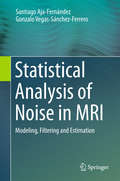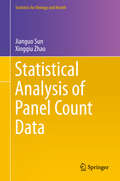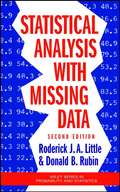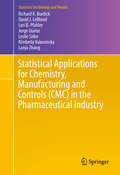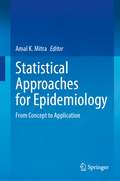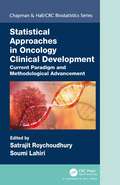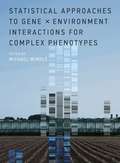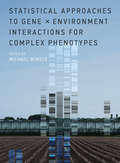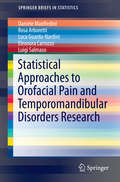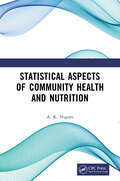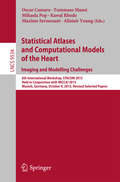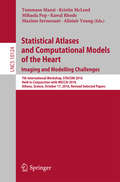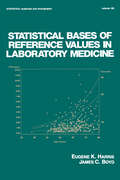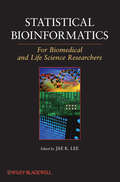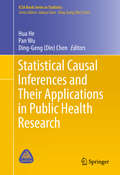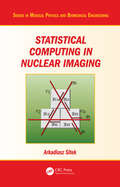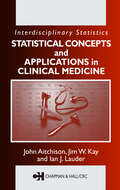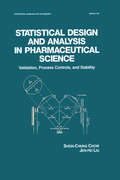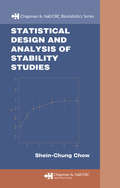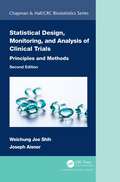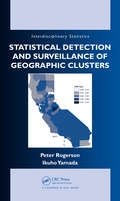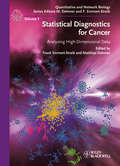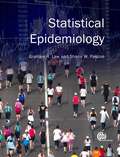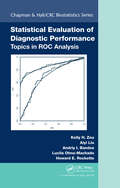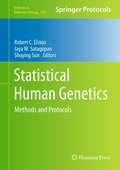- Table View
- List View
Statistical Analysis of Noise in MRI
by Santiago Aja-Fernández Gonzalo Vegas-Sánchez-FerreroThis unique text presents a comprehensive review of methods for modeling signal and noise in magnetic resonance imaging (MRI), providing a systematic study, classifying and comparing the numerous and varied estimation and filtering techniques. Features: provides a complete framework for the modeling and analysis of noise in MRI, considering different modalities and acquisition techniques; describes noise and signal estimation for MRI from a statistical signal processing perspective; surveys the different methods to remove noise in MRI acquisitions from a practical point of view; reviews different techniques for estimating noise from MRI data in single- and multiple-coil systems for fully sampled acquisitions; examines the issue of noise estimation when accelerated acquisitions are considered, and parallel imaging methods are used to reconstruct the signal; includes appendices covering probability density functions, combinations of random variables used to derive estimators, and useful MRI datasets.
Statistical Analysis of Panel Count Data
by Jianguo Sun Xingqiu ZhaoPanel count data occur in studies that concern recurrent events, or event history studies, when study subjects are observed only at discrete time points. By recurrent events, we mean the event that can occur or happen multiple times or repeatedly. Examples of recurrent events include disease infections, hospitalizations in medical studies, warranty claims of automobiles or system break-downs in reliability studies. In fact, many other fields yield event history data too such as demographic studies, economic studies and social sciences. For the cases where the study subjects are observed continuously, the resulting data are usually referred to as recurrent event data. This book collects and unifies statistical models and methods that have been developed for analyzing panel count data. It provides the first comprehensive coverage of the topic. The main focus is on methodology, but for the benefit of the reader, the applications of the methods to real data are also discussed along with numerical calculations. There exists a great deal of literature on the analysis of recurrent event data. This book fills the void in the literature on the analysis of panel count data. This book provides an up-to-date reference for scientists who are conducting research on the analysis of panel count data. It will also be instructional for those who need to analyze panel count data to answer substantive research questions. In addition, it can be used as a text for a graduate course in statistics or biostatistics that assumes a basic knowledge of probability and statistics.
Statistical Analysis with Missing Data
by Roderick J. A. Little Donald B. RubinStatistical analysis of data sets with missing values is a pervasive problem for which standard methods are of limited value. The first edition of Statistical Analysis with Missing Data has been a standard reference on missing-data methods. Now, reflecting extensive developments in Bayesian methods for simulating posterior distributions, this Second Edition by two acknowledged experts on the subject offers a thoroughly up-to-date, reorganized survey of current methodology for handling missing-data problems. Blending theory and application, authors Roderick Little and Donald Rubin review historical approaches to the subject and describe rigorous yet simple methods for multivariate analysis with missing values. They then provide a coherent theory for analysis of problems based on likelihoods derived from statistical models for the data and the missing-data mechanism and apply the theory to a wide range of important missing-data problems. The new edition now enlarges its coverage to include: Expanded coverage of Bayesian methodology, both theoretical and computational, and of multiple imputation Analysis of data with missing values where inferences are based on likelihoods derived from formal statistical models for the data-generating and missing-data mechanisms Applications of the approach in a variety of contexts including regression, factor analysis, contingency table analysis, time series, and sample survey inference Extensive references, examples, and exercises Amstat News asked three review editors to rate their top five favorite books in the September 2003 issue. Statistical Analysis With Missing Data was among those chosen.
Statistical Applications for Chemistry, Manufacturing and Controls (CMC) in the Pharmaceutical Industry
by Lanju Zhang Richard K. Burdick David J. Leblond Lori B. Pfahler Jorge Quiroz Leslie Sidor Kimberly VukovinskyThis book examines statistical techniques that are critically important to Chemistry, Manufacturing, and Control (CMC) activities. Statistical methods are presented with a focus on applications unique to the CMC in the pharmaceutical industry. The target audience consists of statisticians and other scientists who are responsible for performing statistical analyses within a CMC environment. Basic statistical concepts are addressed in Chapter 2 followed by applications to specific topics related to development and manufacturing. The mathematical level assumes an elementary understanding of statistical methods. The ability to use Excel or statistical packages such as Minitab, JMP, SAS, or R will provide more value to the reader. The motivation for this book came from an American Association of Pharmaceutical Scientists (AAPS) short course on statistical methods applied to CMC applications presented by four of the authors. One of the course participants asked us for a good reference book, and the only book recommended was written over 20 years ago by Chow and Liu (1995). We agreed that a more recent book would serve a need in our industry. Since we began this project, an edited book has been published on the same topic by Zhang (2016). The chapters in Zhang discuss statistical methods for CMC as well as drug discovery and nonclinical development. We believe our book complements Zhang by providing more detailed statistical analyses and examples.
Statistical Approaches for Epidemiology: From Concept to Application
by Amal K. MitraThis textbook provides the basic concepts of epidemiology while preparing readers with the skills of applying statistical tools in real-life situations. Students, in general, struggle with statistical theories and their practical applications. This book makes statistical concepts easy to understand by focusing on real-life examples, case studies, and exercises. It also provides step-by-step guides for data analysis and interpretation using standard statistical software such as SPSS, SAS, R, Python, and GIS as appropriate, illustrating the concepts.Through the book's 23 chapters, readers primarily learn how to apply statistical methods in epidemiological studies and problem-solving. Among the topics covered:Clinical TrialsEpidemic Investigation and ControlGeospatial Applications in EpidemiologySurvival Analysis and Applications Using SAS and SPSSSystematic Review and Meta-Analysis: Evidence-based Decision-Making in Public HealthMissing Data Imputation: A Practical Guide Artificial Intelligence and Machine LearningMultivariate Linear Regression and Logistics Regression Analysis Using SASEach chapter is written by eminent scientists and experts worldwide, including contributors from institutions in the United States, Canada, Bangladesh, India, Hong Kong, Malaysia, and the Middle East. Statistical Approaches for Epidemiology: From Concept to Application is an all-in-one book that serves as an essential text for graduate students, faculty, instructors, and researchers in public health and other branches of health sciences, as well as a useful resource for health researchers in industry, public health and health department professionals, health practitioners, and health research organizations and non-governmental organizations. The book also will be helpful for graduate students and faculty in related disciplines such as data science, nursing, social work, environmental health, occupational health, computer science, statistics, and biology.
Statistical Approaches in Oncology Clinical Development: Current Paradigm and Methodological Advancement (Chapman & Hall/CRC Biostatistics Series)
by Satrajit Roychoudhury Soumi LahiriStatistical Approaches in Oncology Clinical Development : Current Paradigm and Methodological Advancement presents an overview of statistical considerations in oncology clinical trials, both early and late phase of development. It illustrates how novel statistical methods can enrich the design and analysis of modern oncology trials. The authors include many relevant real life examples from the pharmaceutical industry and academia based on their first-hand experience. Along with relevant references, the book highlights current regulatory views. The book covers all aspects of cancer clinical trial starting from early phase development. The early part of the book covers novel phase I dose escalation design, exposure response analysis, and innovative phase II design. This includes early development strategy for cancer immunotherapy trials. The contributors also emphasized the role of biomarker and modern era of precision medicine. The second part focuses on the late stage development. This includes the application of adaptive design, safety analysis, and quality of life (QoL) data analysis. The final part discusses current regulatory perspective and challenges. Features: Covers a wide spectrum of topics related to real-life statistical challenges in oncology clinical trials. Provides a comprehensive overview of novel statistical methods to improve trial design and statistical analysis. Detailed case studies illustrate the real life applications. Satrajit Roychoudhury is a Senior Director and a member of the Statistical Research and Innovation group in Pfizer Inc. Prior to joining; he was a member of Statistical Methodology and consulting group in Novartis. He has 11 years of extensive experience in working with different phases of clinical trial. His area of research includes early phase oncology trials, survival analysis, model informed drug development, and use of Bayesian methods in clinical trials. He is industry co-chair for the ASA Biopharmaceutical Section Regulatory-Industry Workshop and has provided statistical training in major conferences including the Joint Statistical Meetings, ASA Biopharmaceutical Section Regulatory-Industry Workshop, and ICSA Applied Statistics Symposium. Soumi Lahiri has 12 years of extensive experience in working different therapeutic areas. She is the former Director of Biostatistics in Clinical Oncology, GlaxoSmithKline. She has also worked in the oncology division of Novartis Pharmaceutical Company for two years. She is an active member of the ASA Biopharmaceutical section and former chair of the membership committee.
Statistical Approaches to Gene x Environment Interactions for Complex Phenotypes
by Michael WindleFindings from the Human Genome Project and from Genome-Wide Association (GWA) studies indicate that many diseases and traits manifest a more complex genomic pattern than previously assumed. These findings, and advances in high-throughput sequencing, suggest that there are many sources of influence -- genetic, epigenetic, and environmental. This volume investigates the role of the interactions of genes and environment (G × E) in diseases and traits (referred to by the contributors as complex phenotypes) including depression, diabetes, obesity, and substance use. The contributors first present different statistical approaches or strategies to address G × E and G × G interactions with high-throughput sequenced data, including two-stage procedures to identify G × E and G × G interactions, marker-set approaches to assessing interactions at the gene level, and the use of a partial-least square (PLS) approach. The contributors then turn to specific complex phenotypes, research designs, or combined methods that may advance the study of G × E interactions, considering such topics as randomized clinical trials in obesity research, longitudinal research designs and statistical models, and the development of polygenic scores to investigate G × E interactions.ContributorsFatima Umber Ahmed, Yin-Hsiu Chen, James Y. Dai, Caroline Y. Doyle, Zihuai He, Li Hsu, Shuo Jiao, Erin Loraine Kinnally, Yi-An Ko, Charles Kooperberg, Seunggeun Lee, Arnab Maity, Jeanne M. McCaffery, Bhramar Mukherjee, Sung Kyun Park, Duncan C. Thomas, Alexandre Todorov, Jung-Ying Tzeng, Tao Wang, Michael Windle, Min Zhang
Statistical Approaches to Gene x Environment Interactions for Complex Phenotypes
by Michael WindleDiverse methodological and statistical approaches for investigating the role of gene-environment interactions in a range of complex diseases and traits. Findings from the Human Genome Project and from Genome-Wide Association (GWA) studies indicate that many diseases and traits manifest a more complex genomic pattern than previously assumed. These findings, and advances in high-throughput sequencing, suggest that there are many sources of influence—genetic, epigenetic, and environmental. This volume investigates the role of the interactions of genes and environment (G × E) in diseases and traits (referred to by the contributors as complex phenotypes) including depression, diabetes, obesity, and substance use. The contributors first present different statistical approaches or strategies to address G × E and G × G interactions with high-throughput sequenced data, including two-stage procedures to identify G × E and G × G interactions, marker-set approaches to assessing interactions at the gene level, and the use of a partial-least square (PLS) approach. The contributors then turn to specific complex phenotypes, research designs, or combined methods that may advance the study of G × E interactions, considering such topics as randomized clinical trials in obesity research, longitudinal research designs and statistical models, and the development of polygenic scores to investigate G × E interactions. Contributors Fatima Umber Ahmed, Yin-Hsiu Chen, James Y. Dai, Caroline Y. Doyle, Zihuai He, Li Hsu, Shuo Jiao, Erin Loraine Kinnally, Yi-An Ko, Charles Kooperberg, Seunggeun Lee, Arnab Maity, Jeanne M. McCaffery, Bhramar Mukherjee, Sung Kyun Park, Duncan C. Thomas, Alexandre Todorov, Jung-Ying Tzeng, Tao Wang, Michael Windle, Min Zhang
Statistical Approaches to Orofacial Pain and Temporomandibular Disorders Research
by Luigi Salmaso Rosa Arboretti Daniele Manfredini Luca Guarda Nardini Eleonora CarrozzoThis book covers some biostatistical methods and several case studies useful to interpret and analyze dental research in the areas of orofacial pain and temporomandibular disorders. It will guide practitioners in these fields who would like to interpret research findings or find examples on the design of clinical investigations. After an introduction dealing with the basic issues, the central sections of the textbook are dedicated to the different types of investigations in sight of specific goals researchers may have. The final section contains a recent approach based on nonparametric permutation tests which can be adopted in many practical situations. The field of orofacial pain and temporomandibular disorders is emerging as one of the most critical areas of clinical research in dentistry. Due to the complexity of clinical pictures, the multifactorial etiology, and the importance of psychosocial factors in all aspects of the TMD practice, clinicians often find it hard to appraise their modus operandi, and researchers must constantly increase their knowledge in epidemiology and medical statistics. Indeed, proper methodological designs are fundamental to reaching high levels of internal and external validity of findings in this specific area.
Statistical Aspects of Community Health and Nutrition
by A. K. NigamThis book provides a detailed view of public nutrition and health. It discusses the various statistical tools and their appropriate application in public health and nutrition research, surveys, evaluation and program designing. The subject matter of this book covers a range of topics including statistical issues pertaining to measurement of hunger and food security, hunger mapping, diseases in community clusters, randomized response technique for sensitive characteristics, small area estimation and gender disparity.Print edition not for sale in South Asia (India, Sri Lanka, Nepal, Bangladesh, Pakistan and Bhutan)
Statistical Atlases and Computational Models of the Heart. Imaging and Modelling Challenges
by Oscar Camara Tommaso Mansi Mihaela Pop Kawal Rhode Maxime Sermesant Alistair YoungThis book constitutes the thoroughly refereed post-workshop proceedings of the 6th International Workshop on Statistical Atlases and Computational Models of the Heart: Imaging and Modelling Challenges, STACOM 2015, held in conjunction with MICCAI 2015, in Munich, Germany, in October 2015. The 23 revised full workshop papers were carefully reviewed and selected from 34 submissions. The papers cover a wide range of topics such cardiac image processing, atlas construction, statistical modeling of cardiac function across different patient populations, cardiac mapping, cardiac computational physiology, model customization, image-based modelling and image-guided interventional procedures, atlas based functional analysis, ontological schemata for data and results, integrated functional and structural analysis.
Statistical Atlases and Computational Models of the Heart. Imaging and Modelling Challenges
by Tommaso Mansi Mihaela Pop Kawal Rhode Maxime Sermesant Alistair Young Kristin McleodThis book constitutes the thoroughly refereed post-workshop proceedings of the 7th International Workshop on Statistical Atlases and Computational Models of the Heart: Imaging and Modelling Challenges. 7th International Workshop, STACOM 2016, Held in conjunction with MICCAI 2016, Athens, Greece, October 17, 2016, Revised Selected papers The 24 revised full workshop papers were carefully reviewed and selected from 32 submissions. The papers cover a wide range of topics such as cardiac image processing; atlas construction, statistical modelling of cardiac function across different patient populations; cardiac mapping, cardiac computational physiology; model customization; image-based modelling and image-guided interventional procedures; atlas based functional analysis, ontological schemata for data and results; integrated functional and structural analyses; pre-clinical and clinical applicability of the methods described.
Statistical Bases of Reference Values in Laboratory Medicine
by Eugene K. Harris James C. BoydExamining the strengths and limitations of various standards of accuracy in clinical laboratory analyses, this detailed reference presents an in-depth study of important theoretical and empirical issues concerning the description, collection, and application of reference values in laboratory medicine.
Statistical Bioinformatics
by Jae K. LeeThis book provides an essential understanding of statistical concepts necessary for the analysis of genomic and proteomic data using computational techniques. The author presents both basic and advanced topics, focusing on those that are relevant to the computational analysis of large data sets in biology. Chapters begin with a description of a statistical concept and a current example from biomedical research, followed by more detailed presentation, discussion of limitations, and problems. The book starts with an introduction to probability and statistics for genome-wide data, and moves into topics such as clustering, classification, multi-dimensional visualization, experimental design, statistical resampling, and statistical network analysis. Clearly explains the use of bioinformatics tools in life sciences research without requiring an advanced background in math/statisticsEnables biomedical and life sciences researchers to successfully evaluate the validity of their results and make inferencesEnables statistical and quantitative researchers to rapidly learn novel statistical concepts and techniques appropriate for large biological data analysisCarefully revisits frequently used statistical approaches and highlights their limitations in large biological data analysisOffers programming examples and datasetsIncludes chapter problem sets, a glossary, a list of statistical notations, and appendices with references to background mathematical and technical materialFeatures supplementary materials, including datasets, links, and a statistical package available onlineStatistical Bioinformatics is an ideal textbook for students in medicine, life sciences, and bioengineering, aimed at researchers who utilize computational tools for the analysis of genomic, proteomic, and many other emerging high-throughput molecular data. It may also serve as a rapid introduction to the bioinformatics science for statistical and computational students and audiences who have not experienced such analysis tasks before.
Statistical Causal Inferences and Their Applications in Public Health Research
by Ding-Geng Din Chen Hua He Pan WuThis book compiles and presents new developments in statistical causal inference. The accompanying data and computer programs are publicly available so readers may replicate the model development and data analysis presented in each chapter. In this way, methodology is taught so that readers may implement it directly. The book brings together experts engaged in causal inference research to present and discuss recent issues in causal inference methodological development. This is also a timely look at causal inference applied to scenarios that range from clinical trials to mediation and public health research more broadly. In an academic setting, this book will serve as a reference and guide to a course in causal inference at the graduate level (Master's or Doctorate). It is particularly relevant for students pursuing degrees in statistics, biostatistics, and computational biology. Researchers and data analysts in public health and biomedical research will also find this book to be an important reference.
Statistical Computing in Nuclear Imaging (ISSN #32)
by Arkadiusz SitekStatistical Computing in Nuclear Imaging introduces aspects of Bayesian computing in nuclear imaging. The book provides an introduction to Bayesian statistics and concepts and is highly focused on the computational aspects of Bayesian data analysis of photon-limited data acquired in tomographic measurements. Basic statistical concepts, elements of
Statistical Concepts and Applications in Clinical Medicine
by John Aitchison Jim W. Kay Ian J. LauderStatistical Concepts and Applications in Clinical Medicine presents a unique, problem-oriented approach to using statistical methods in clinical medical practice through each stage of the clinical process, including observation, diagnosis, and treatment. The authors present each consultative problem in its original form, then describe the process o
Statistical Design and Analysis in Pharmaceutical Science: Validation, Process Controls, and Stability
by Shein-Chung Chow Jen-pei Liu"Offers a comprehensive, unified presentation of statistical designs and methods of analysis for all stages of pharmaceutical development--emphasizing biopharmaceutical applications and demonstrating statistical techniques with real-world examples."
Statistical Design and Analysis of Stability Studies (Chapman & Hall/CRC Biostatistics Series)
by Shein-Chung ChowThe US Food and Drug Administration's Report to the Nation in 2004 and 2005 indicated that one of the top reasons for drug recall was that stability data did not support existing expiration dates. Pharmaceutical companies conduct stability studies to characterize the degradation of drug products and to estimate drug shelf life. Illustrating how sta
Statistical Design, Monitoring, and Analysis of Clinical Trials: Principles and Methods (Chapman & Hall/CRC Biostatistics Series)
by Weichung Joe Shih Joseph AisnerStatistical Design, Monitoring, and Analysis of Clinical Trials, Second Edition concentrates on the biostatistics component of clinical trials. This new edition is updated throughout and includes five new chapters.Developed from the authors’ courses taught to public health and medical students, residents, and fellows during the past 20 years, the text shows how biostatistics in clinical trials is an integration of many fundamental scientific principles and statistical methods. The book begins with ethical and safety principles, core trial design concepts, the principles and methods of sample size and power calculation, and analysis of covariance and stratified analysis. It then focuses on sequential designs and methods for two-stage Phase II cancer trials to Phase III group sequential trials, covering monitoring safety, futility, and efficacy. The authors also discuss the development of sample size reestimation and adaptive group sequential procedures, phase 2/3 seamless design and trials with predictive biomarkers, exploit multiple testing procedures, and explain the concept of estimand, intercurrent events, and different missing data processes, and describe how to analyze incomplete data by proper multiple imputations. This text reflects the academic research, commercial development, and public health aspects of clinical trials. It gives students and practitioners a multidisciplinary understanding of the concepts and techniques involved in designing, monitoring, and analyzing various types of trials. The book’s balanced set of homework assignments and in-class exercises are appropriate for students and researchers in (bio)statistics, epidemiology, medicine, pharmacy, and public health.
Statistical Detection and Surveillance of Geographic Clusters (Chapman & Hall/CRC Interdisciplinary Statistics)
by Peter Rogerson Ikuho YamadaThe widespread popularity of geographic information systems (GIS) has led to new insights in countless areas of application. It has facilitated not only the collection and storage of geographic data, but also the display of such data. Building on this progress by using an integrated approach, Statistical Detection and Monitoring of Geographic Clust
Statistical Diagnostics for Cancer: Analyzing High-Dimensional Data
by Matthias Dehmer Frank Emmert-StreibThis ready reference discusses different methods for statistically analyzing and validating data created with high-throughput methods. As opposed to other titles, this book focusses on systems approaches, meaning that no single gene or protein forms the basis of the analysis but rather a more or less complex biological network. From a methodological point of view, the well balanced contributions describe a variety of modern supervised and unsupervised statistical methods applied to various large-scale datasets from genomics and genetics experiments. Furthermore, since the availability of sufficient computer power in recent years has shifted attention from parametric to nonparametric methods, the methods presented here make use of such computer-intensive approaches as Bootstrap, Markov Chain Monte Carlo or general resampling methods. Finally, due to the large amount of information available in public databases, a chapter on Bayesian methods is included, which also provides a systematic means to integrate this information. A welcome guide for mathematicians and the medical and basic research communities.
Statistical Epidemiology
by Shane Pascoe Graham LawStatistics are a vital skill for epidemiologists and form an essential part of clinical medicine and public health. This textbook introduces students to statistical epidemiology methods in a carefully structured and accessible format. With clearly defined learning outcomes, the suggested chapter orders can be tailored to the needs of students at both undergraduate and graduate level from a range of academic backgrounds. The book covers study design, measuring disease, bias, error, analysis and modelling and is illustrated with figures, focus boxes, study questions and examples applicable to everyday clinical problems. Drawing on the authors' extensive teaching experience, the text provides an introduction to core statistical epidemiology that will be a valuable resource for students and lecturers in health and medical sciences and applied statistics, health staff, clinical researchers and data managers.
Statistical Evaluation of Diagnostic Performance: Topics in ROC Analysis (Chapman & Hall/CRC Biostatistics Series)
by Kelly H. Zou Aiyi Liu Andriy I. Bandos Lucila Ohno-Machado Howard E. RocketteStatistical evaluation of diagnostic performance in general and Receiver Operating Characteristic (ROC) analysis in particular are important for assessing the performance of medical tests and statistical classifiers, as well as for evaluating predictive models or algorithms. This book presents innovative approaches in ROC analysis, which are releva
Statistical Human Genetics
by Robert C. Elston Shuying Sun Jaya M. SatagopanRecent advances in genetics over the last quarter of a century, especially in molecular techniques, have dramatically reduced the cost of determining genetic markers and hence opened up a field of research that is increasingly helping to detect, prevent and/or cure many diseases that afflict humans. In Statistical Human Genetics: Methods and Protocols expert researchers in the field describe statistical methods and computer programs in the detail necessary to make them more easily accessible to the beginner analyzing data. Written in the highly successful Methods in Molecular BiologyTM series format, with examples of running the programs and interpreting the program outputs, the chapters include the kind of detailed description and implementation advice that is crucial for getting optimal results from human genetic data collected in the laboratory. Thorough and as much as possible intuitive, Statistical Human Genetics: Methods and Protocols aids scientists in understanding the computer programs and analytical procedures they need to use.
